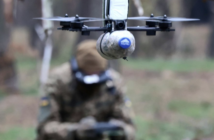Welcome to the CavasShips Podcast with Christopher P. Cavas and Chris Servello…a weekly podcast looking at naval and maritime events and issues of the day – in the US, across the seas and around the world. This week…we are joined by retired Admiral Bill Moran. The former Vice Chief of Naval Operations and Chief of Naval Personnel talks about fleet manning, how to better use technology when recruiting, training and retaining Sailors and gives his views on Ukraine lessons learned from the Russo-Ukrainian conflict and how the U.S. Navy stacks up against their competitors in the Chinese Navy.
Please send us feedback by DM’ing @CavasShips or @CSSProvision or you can email chriscavas@gmail.com or cservello@defaeroreport.com.
This Week’s Naval Round Up:
The carrier USS HARRY S TRUMAN returned to her homeport of Norfolk, Virginla September 12 after a nine-month deployment with Carrier Air Wing ONE to the European Theater of Command. TRUMAN spent virtually the entire cruise operating around the central Mediterranean Sea in response to Russia’s February invasion of Ukraine.
Also on September 12 but in the Pacific, the carrier USS RONALD REAGAN left Yokosuka, Japan to continue a regional cruise that began in May. The carrier paused for about three weeks beginning August 19 before getting underway again to operate with Carrier Air Wing FIVE.
NATO’s Exercise Dynamic Mariner began September 11 in the Aegean Sea near Turkey as well as in the Sea of Marmara. The crisis-response exercise is coordinated with the Turkish Exercise Mavi Balina, and includes fifty warships, five submarines and five aircraft from 12 NATO countries – Belgium, Bulgaria, Canada, France, Germany, Greece, Italy, Poland, Romania, Spain, Turkey and the U.S. A major goal of the exercise is to test NATO’s Maritime Response Forces.
And the USS CORONADO (LCS 4) was decommissioned September 14 in a ceremony at San Diego after a service live of just over eight years. The second of the Independence-class of littoral combat ships, CORONADO carried out just one Western Pacific deployment during her career. After entering service in 2014 the Navy often referred to the CORONADO and the first-in-class INDEPENDENCE as prototype vessels, and subsequent ships in the class incorporated numerous changes. CORONADO joins her sistership INDEPENDENCE – decommissioned in July 2021 – in the reserve fleet at Bremerton, Washington.
Servello Squawk:
Thanks Chris….let me share with you my nirvana for how a robust and capable Navy is conceived, argued for, funded and ultimately built.
In my ideal world the Secretary of the Navy and Chief of Naval Operations would develop and publish a Force Structure Assessment telling the Congress, Industry and the public what type of Navy the country needs in order to help keep America safe and our interests protected.
SECNAV and CNO would explain and defend their recommendations to the Congress providing their best professional advice.
The Congress would then balance their advice and recommendations with that of the Administration’s budget submission and would authorize and fund the building, modernizing and maintaining of the Navy through the authorization and appropriations process.
Based on the credible and consistent plans articulated by the Navy and approved by Congress, industry would grow and maintain the workforce and technical capability needed to meet those plans…while balancing the interests of their Navy customer with that of their shareholders.
Helping this process along are multi-year deals, good faith discussions, and candid testimonials that lay out a clear requirement that industry leaders can plan to and invest in.
What’s not helpful to the process are Navy leaders that constantly change their story, provide moving requirements, and spend more time telling key audiences what industry can’t do instead of what they need them to do.
This past week CNO Admiral Mike Gilday once again publicly pushed back on the idea of growing the fleet because he believes America’s shipbuilding industry doesn’t have the capacity to meet an increase in the number of ships they build each year.
I believe the CNO’s approach is both inaccurate and unhelpful. We are at a crossroads of opportunity to build a joint force with the right capability and capacity to deter the Chinese, Russians, Koreans and others.
Excuses about why we can’t do things deter no body.
We need a CNO that proposes a cogent and responsible fleet architecture and building plan and then convincingly explains the risks associated with not meeting that plan.
Admiral Gilday please tell Congress and the shipbuilders what we need and then work with them to fund and build it.
Let’s not miss this important moment by telling us what we can not do…please tell us what we need to do to keep America safe.




